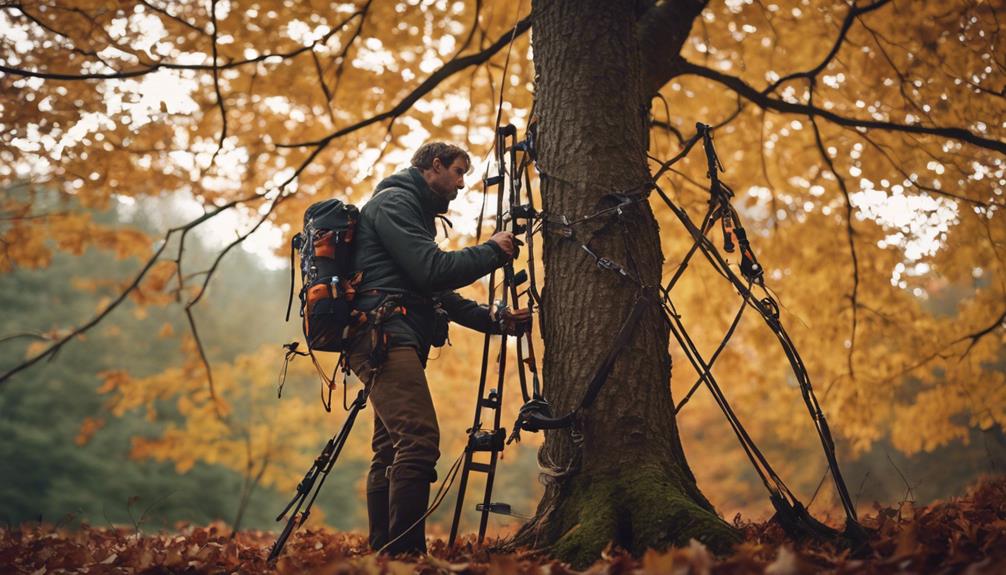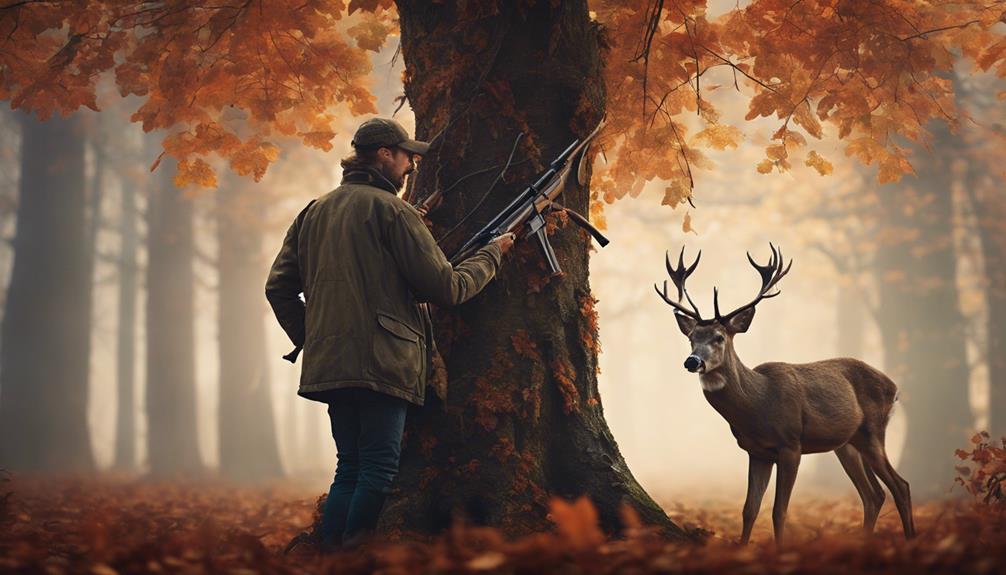How to Use a Climbing Tree Stand: A Complete Guide for Safe and Successful Hunting
To use a climbing tree stand effectively, start by choosing a sturdy tree at least 8 inches in diameter. Inspect your stand and safety harness for wear before climbing. Securely attach the stand about 15 to 20 feet high, ensuring it’s stable and comfortable. As you climb, maintain three points of contact for safety, moving slowly and deliberately. Once settled, stay still and silent to avoid spooking game. After your hunt, carefully descend and disassemble the stand. With practice and attention to detail, you’ll improve your skills and hunting success, ready to uncover more tips for your next outing.
Choosing the Right Stand

When selecting the perfect climbing tree stand, consider factors like weight, height, and comfort to guarantee it suits your hunting needs.
Start by exploring different stand types: climbers, hang-ons, and ladder stands. Each offers unique advantages, so think about your hunting style and terrain. Climbers are lightweight and great for quick setups, while hang-ons provide stability and comfort.
Next, check the weight capacity. You want a stand that can support not just your weight, but also any gear you’ll bring along. Most stands will have a specified weight limit, so make sure it exceeds your total combined weight for safety.
Height is another important factor. Depending on your hunting strategy, you might want a stand that allows you to climb high for better visibility and scent control. However, keep in mind your comfort and ability to maneuver while up there.
Lastly, don’t forget about comfort. A well-padded seat and spacious platform can make a long day of hunting much more enjoyable.
Preparing for the Hunt
Before heading out, take a moment to meticulously check your gear, guaranteeing everything from your climbing tree stand to your safety harness is in top condition for a successful hunt. Use this pre-hunt checklist to guide your preparation:
- Climbing Tree Stand: Inspect for any wear and tear. Guarantee all parts are functioning smoothly.
- Safety Harness: Check for frays or damage. A secure harness is critical for safety.
- Climbing Gear: Verify your ropes and carabiners are intact and easily accessible.
- Essential Supplies: Pack your backpack with snacks, water, and any tools you might need.
Once your gear is ready, shift your focus to mental preparation. Visualize your hunting location and your strategy for the day.
Take a few moments to calm your mind; deep breaths can help clear any nerves.
Safety Gear Essentials

Equipping yourself with the right safety gear is vital for a secure and enjoyable climbing experience.
Start with a quality harness; understand the different harness types available, such as full-body and sit harnesses. A full-body harness offers additional support and stability, making it ideal for beginners, while a sit harness provides more freedom of movement for experienced climbers.
Next, always wear a helmet to protect your head from falling debris. Confirm your helmet fits snugly and meets safety standards. Additionally, use a safety line that connects your harness to the tree stand. This line acts as a lifeline, reducing the risk of falls during your ascent and descent.
Following proper safety protocols is imperative. Before climbing, inspect all your gear for any signs of wear and tear. Verify your climbing tree stand is secure and stable before stepping onto it. Always follow the manufacturer’s instructions for setup and usage.
Finding the Perfect Tree
Choosing the right tree is key to maximizing your climbing tree stand experience and guaranteeing your safety while you hunt or observe wildlife. When you’re scouting for that perfect tree, keep these essential tree characteristics and location factors in mind:
- Tree Stability: Look for a straight, sturdy tree with a diameter of at least 8 inches. Avoid dead or damaged trees that could pose risks.
- Surrounding Cover: Choose a tree that offers good cover from the elements and provides you with a natural backdrop to help conceal your presence from wildlife.
- Height Considerations: Aim for a height that gives you a clear line of sight but isn’t too elevated to compromise your safety. Typically, 15 to 25 feet is ideal for visibility and concealment.
- Access Points: Guarantee there’s a clear path for climbing and descending. Check for branches or obstacles that could hinder your movement.
Setting Up Your Stand

Once you’ve found the perfect tree, it’s time to carefully position your climbing tree stand for ideal safety and effectiveness.
Start by considering the tree’s diameter and bark condition—aim for a sturdy, straight tree with rough bark, which helps in gripping. Make sure your stand is at least 15 to 20 feet off the ground for best visibility and safety.
Next, evaluate stand location considerations. Look for areas with ample cover, nearby food sources, and trails used by game. Position your stand downwind of these trails to avoid spooking animals.
Before you climb, perform thorough tree stand maintenance. Inspect the stand for any wear and tear, making certain all straps and safety harnesses are in good condition. Lubricate moving parts if necessary and check for rust or damage. Make adjustments as needed to guarantee a secure fit.
Once you’ve confirmed everything is in top shape, carefully attach your stand and double-check all connections. By taking these precautions, you’ll create a safe and effective setup, ready for an enjoyable and successful hunting experience.
Climbing Techniques
To ascend the tree safely and efficiently, you’ll want to master the art of using your climbing tree stand with confidence and precision.
Understanding effective climbing methods is key to achieving stand stability as you navigate upward. Here are some essential techniques to keep in mind:
- Choose the Right Tree: Look for a straight, sturdy tree with no branches for the first 10-12 feet, ensuring your stand can be securely attached.
- Check Your Gear: Before climbing, double-check that your harness, ropes, and stand are in good condition. Any wear can compromise your safety.
- Maintain Three Points of Contact: As you climb, always keep two hands and one foot, or two feet and one hand in contact with the tree or stand. This enhances your balance and stability.
- Climb Slowly and Steadily: Take your time as you ascend. Rushing can lead to mistakes or loss of balance, so focus on maintaining control.
Hunting From the Stand

After you’ve safely ascended and secured your climbing tree stand, it’s time to focus on hunting from your elevated perch, where patience and strategy become your best allies. From this vantage point, you can observe the landscape and spot potential game without being detected.
Implement effective hunting strategies by choosing your shooting lanes wisely. Clear any obstructions in your line of sight and make certain you’re ready to take your shot quickly. Remember, animals are unpredictable, so stay alert and be prepared for sudden movements.
Scent control is essential while hunting from your stand. Use scent-free clothing and wash your gear with specialized detergents to minimize your odor. Position your stand downwind from your target area to avoid alerting animals to your presence.
As you wait, take time to enjoy the surroundings; the stillness can offer unexpected moments of wildlife activity. Stay still and quiet, and avoid unnecessary movements that could give away your position.
With the right mindset and tactics, you’ll increase your chances of a successful hunt while making the most of your time in the treetops.
Taking Down Your Stand
Carefully descend your climbing tree stand, guaranteeing each step is deliberate to maintain your safety and prevent any unnecessary noise that could spook nearby wildlife.
Once you’re safely on the ground, follow these steps for effective stand maintenance and to prepare for proper storage:
- Inspect Your Equipment: Before disassembling, check for any wear or damage. Look for frayed straps or loose bolts that may need repair.
- Remove Accessories: Take off any gear like bows or backpacks, and detach any additional accessories from the stand.
- Disassemble the Stand: Carefully remove the platform and seat, making sure to keep all parts organized. This prevents losing components when you store it.
- Clean and Store: Wipe down the stand to remove dirt and moisture. Use a designated storage area, keeping it dry to prevent rust and guarantee longevity.
Conclusion
Using a climbing tree stand is like mastering a dance with nature—each move requires grace and precision.
As you wrap up your hunt, remember to pack up your stand carefully, leaving no trace behind. Reflect on what you’ve learned and the moments you’ve shared with the wild.
With practice, you’ll become more confident, blending seamlessly into the treetops. So gear up, embrace the adventure, and let the thrill of the hunt guide you to new heights.

